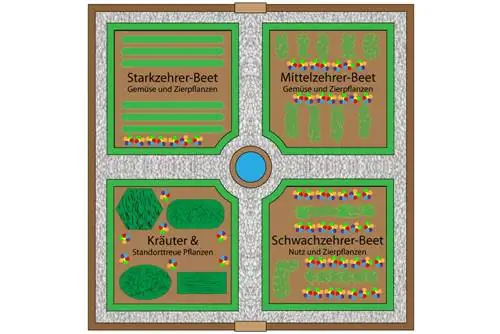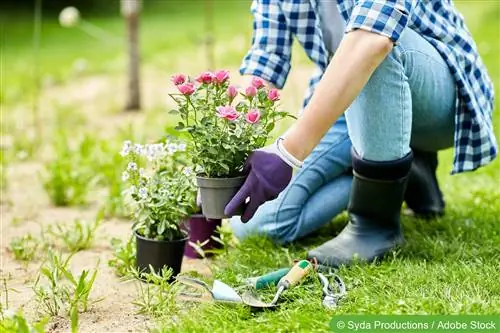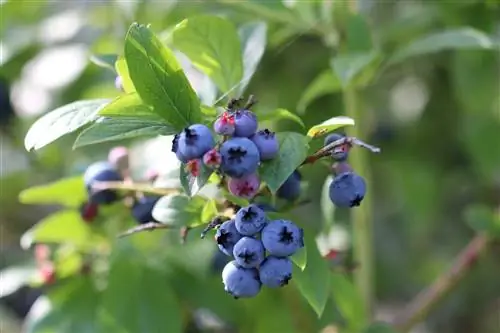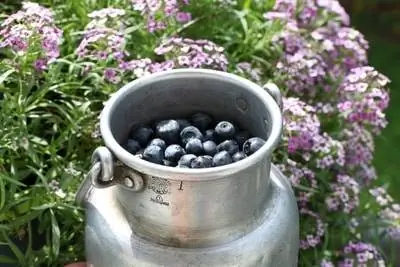- Author admin [email protected].
- Public 2023-12-17 03:39.
- Last modified 2025-01-24 12:45.
When you think of blueberries or blueberries, you usually also think of the delicious blueberry muffins. But the delicious and he althy fruit is also very tasty and popular straight from the bush to the mouth. However, if you want to cultivate the fruit in your garden, you should definitely use cultivated blueberry varieties, which should be planted in local gardens. When is the best time to plant and how best to proceed is explained in detail in the following article.
Suitable varieties
Varieties that can be cultivated in local gardens do not come from the native wild blueberry, Vaccinium myrtillus. This is a cross of the very tasty American blueberry Vaccinium corybosum, which was crossed with other species. This is how the varieties of cultivated blueberries were created, all of which are very tasty, juicy and fruity. The berries are much larger than the local wild blueberries and have light flesh. The fruits also have more taste, but unfortunately also fewer vitamins and minerals. While wild blueberries usually grow as herbs near the ground, cultivated blueberries are bushes that often aim high. Examples that are easy to cultivate are:
- Bluecrop from the USA
- Berkeley also bred in the USA
- Heerma, bred in Germany with origins in America
- Ama, also based on American varieties, bred in Germany
- Spartan, very robust variety
- Elisabeth, late variety
- Liberty, said to guarantee a long harvest
- Hortblue Poppins, has a particularly crunchy pulp
Since the blueberries are self-fertile, they also respond very well to cross-pollination by another variety and respond with a larger yield, it makes sense to plant several different varieties in a garden bed. In addition, you can harvest over a longer period of time, as not all varieties produce their tasty berries at the same time.
Tip:
When buying cultivated blueberries, it makes more sense to use a slightly more expensive but older plant, around four years old. This pays off because the bushes only produce a good harvest after about five to six years. This is much quicker in the home garden with an older plant.
Location
In contrast to the native wild blueberries, which are usually found in shady to semi-shady locations on the edges of forests, the cultivated varieties tend to prefer sunny conditions. But the ideal place should also be a little protected from the wind. The perfect location for a blueberry bed could look like this:
- a fully sunny garden bed in a corner of the garden
- a high fence or hedge offers enough wind protection
- in front of a sunny south-facing house wall
- A place in the shade reduces the crop yield
- the more sun, the more vitamins in the ripe fruits
Tip:
The wind-protected location is particularly important because the earth does not dry out too quickly in the wind. However, if you observe and water every day if necessary, you can also plant the blueberries in an unprotected place if no other bed is available.
Time
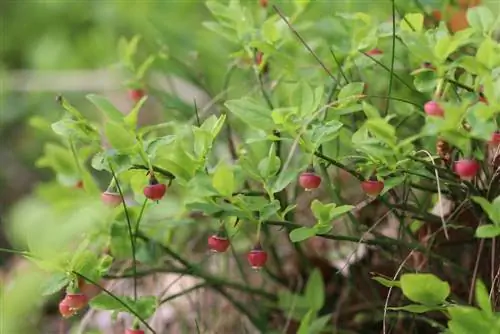
The ideal time to plant the shrubs is either autumn or spring. Container goods can be planted in both seasons, while bare-rooted goods should usually be cultivated in the garden bed in autumn. Which shrubs are purchased here in the garden trade is always a question of cost, because container goods are usually a lot more expensive than the cheaper bare-rooted or baled ones. These must also be used immediately on the day of purchase, or the next day at the latest, whereas the container goods can remain for several days if they are watered regularly. Otherwise, the following should be taken into account when choosing the ideal time:
- don’t wait too long to plant in the fall
- Plant should grow before the first frost
- therefore choose older plants for planting in autumn
- don't plant too early in spring when frost is still expected
- but before the first shoots
- ideal is an overcast day without sunlight and rain
Tip:
In the planting year, especially if the bushes are planted in spring, all flowers should be removed so that the berries can first take root. If it forms flowers at the same time, it puts all its strength into the flowering, the plant could wither.
Tool
Since the soil usually has to be prepared before the bushes are actually planted, some tools are also necessary and should be prepared in advance. The larger the garden bed in which the blueberries are planted, the more work it takes to prepare them. The following tools are required for preparing the soil and for planting:
- Spade
- Shovel
- Wheelbarrow
- Garden fork
- Watering can
- alternatively hose connected to rainwater collection basin
Spades and shovels are needed to dig up the earth and possibly dig it up. The soil can be carted away using the wheelbarrow provided if there is excess as only part of the substrate is to be used and mixed. The garden fork is well suited for lifting compost and peat. Since watering with lime-containing water is not allowed, collected rainwater must be used, which can be taken from the rain barrel using the watering can. Advanced gardeners have a large rainwater collection basin equipped with a hose.
Tip:
Please do not connect the garden hose for watering the blueberries to a municipal water connection. The water is often very calcareous, which can vary greatly from community to community. But the lime it contains is always harmful. If you don't have rainwater available, you should filter the tap water first and water it with a jug.
Preparation/soil conditions
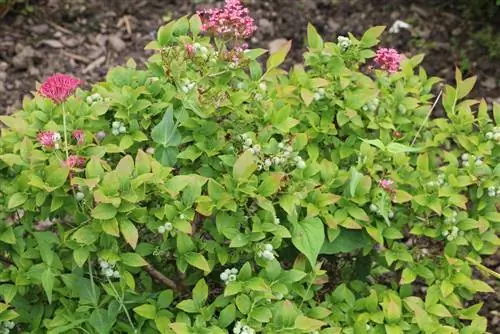
Blueberries are classified in the same plant category as rhododendrons. Above all, this means that calcareous soil is poisonous for the tasty berry plant. The soil at the location should be rather acidic with a pH value between 3.5 and 4.5. If you don't know the nature of the soil at your chosen location, you can quickly determine it using a quick pH test from a well-stocked gardening store. To obtain the desired acidic soil for the blueberries, you can proceed as follows:
- Dig up soil throughout the garden bed
- up to 40 cm deep
- then fill in azalea or rhododendron soil
- alternatively mix garden soil with lots of peat and sand
- fold in a little compost made from spruce needles
- Sawdust from untreated wood
- composted tree bark and leaves
If the soil in the entire garden is normally very calcareous, then the garden bed with the prepared soil for the blueberries must be additionally protected by creating a raised wall of garden soil around the bed. This can prevent the lime from the surrounding soil from getting into the blueberry bed with rainwater and being absorbed by the roots.
Tip:
An increased lime content in the soil is indicated by the plants with yellow leaves. The bushes no longer grow. Too much lime usually disrupts iron absorption by the roots.
Planting spacing
In contrast to wild blueberries, cultivated blueberries that are planted in home gardens require more space. When creating the bed for the tall-growing bushes, it is important to ensure that there is enough space between the plants so that they can be easily walked through and picked. In addition, the roots of the plants should not interfere with each other. The ideal planting distance looks like this:
- a distance of 2.5 meters between the individual rows
- place individual plants in the rows at a distance of about 1.5 meters
- an appropriately sized garden bed is required
- for several bushes of tasty berries
- If space is limited, only two plants can be cultivated
- so you don't have to miss out on the tasty berries
However, a single blueberry in the garden is not a good decision because the bushes do not like to stand alone. In addition, with at least two plants of different varieties, the harvest yield is significantly higher through cross-pollination.
Tip:
Blueberries are shallow-rooted, so the planting hole needs to be dug wide rather than deep.
Plants
Once the right location has been found and the soil has been prepared, the blueberries can be planted. To do this, the holes are slightly dug at the appropriate planting distance. The roots of the plants must not be placed too deep in the soil, so it makes more sense to dig the holes wide rather than too deep. Drainage can also be installed in each planting hole to prevent any waterlogging that may occur. Since the blueberries do not tolerate lime, it is better to avoid stones or gravel as a drainage base. In this case, pottery shards are the better choice. These are laid out on the bottom of the planting hole before the shrubs are planted. The procedure is then as follows:
- Don’t plant bushes too deep
- the roots also need oxygen
- carefully and loosely fill in the prepared soil
- don't step on it
- It's better to shake the bush again so that the soil is well distributed
- water well with collected rainwater
- lay mulch around the plants
- so they are protected from possible frost
- Soil stays moist longer
Blueberries are heather plants that should not be planted too deep. Because they react very sensitively to this, it can happen that the roots then die because they do not receive enough oxygen. Therefore, the bushes should only be planted so deep that the upper edge of the root ball should still protrude about one to two centimeters from the raised soil.
Transplanting
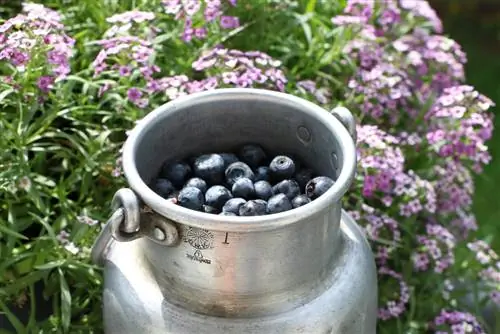
As a rule, the blueberries should be given the right location right from the start. As a rule, the bushes should not be transplanted. If this has to happen, perhaps because too much lime has accumulated in the soil, then you should pay attention to the following information:
- only possible up to the age of around four to five years
- if yields are already expected, do not transplant anymore
- To do this, carefully remove the plants from the soil
- remove all soil from the roots
- water well
- plant in a new location with prepared soil
- carried out in spring, remove all flowers
If the bushes are transplanted in spring, this means that no harvest can be expected this year, as all the flowers have to be removed so that the plant can concentrate on re-rooting. It is therefore always advisable to plant the shrubs in a suitable location right from the start.
Conclusion
It's not that easy to cultivate tasty blueberries in your own garden. Many different things must be taken into account when planting, the soil conditions and the location. And several shrubs in a large bed also require a lot of space. But if you don't want to miss out on the delicious fruits in the garden, you can just plant two individual bushes in a corner with prepared soil. Here, the subsequent care is not quite as extensive as in a large garden bed with many bushes. Since blueberries are very productive, several delicious blueberry muffins can be baked from just one single bush. If blueberries or blueberries are planted in the right location and cared for well, the plants can live up to thirty years, during which time they continue to produce good yields.



